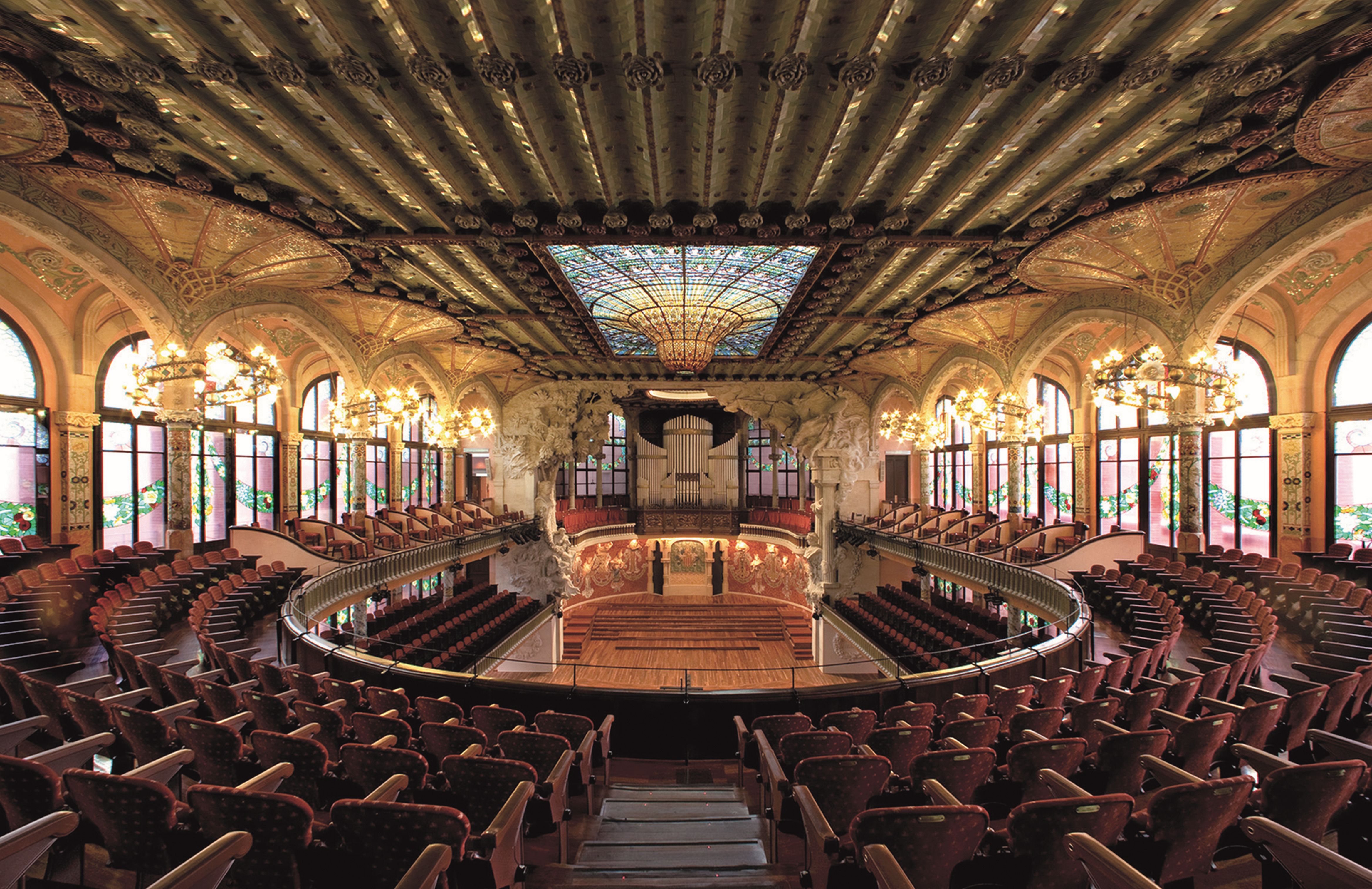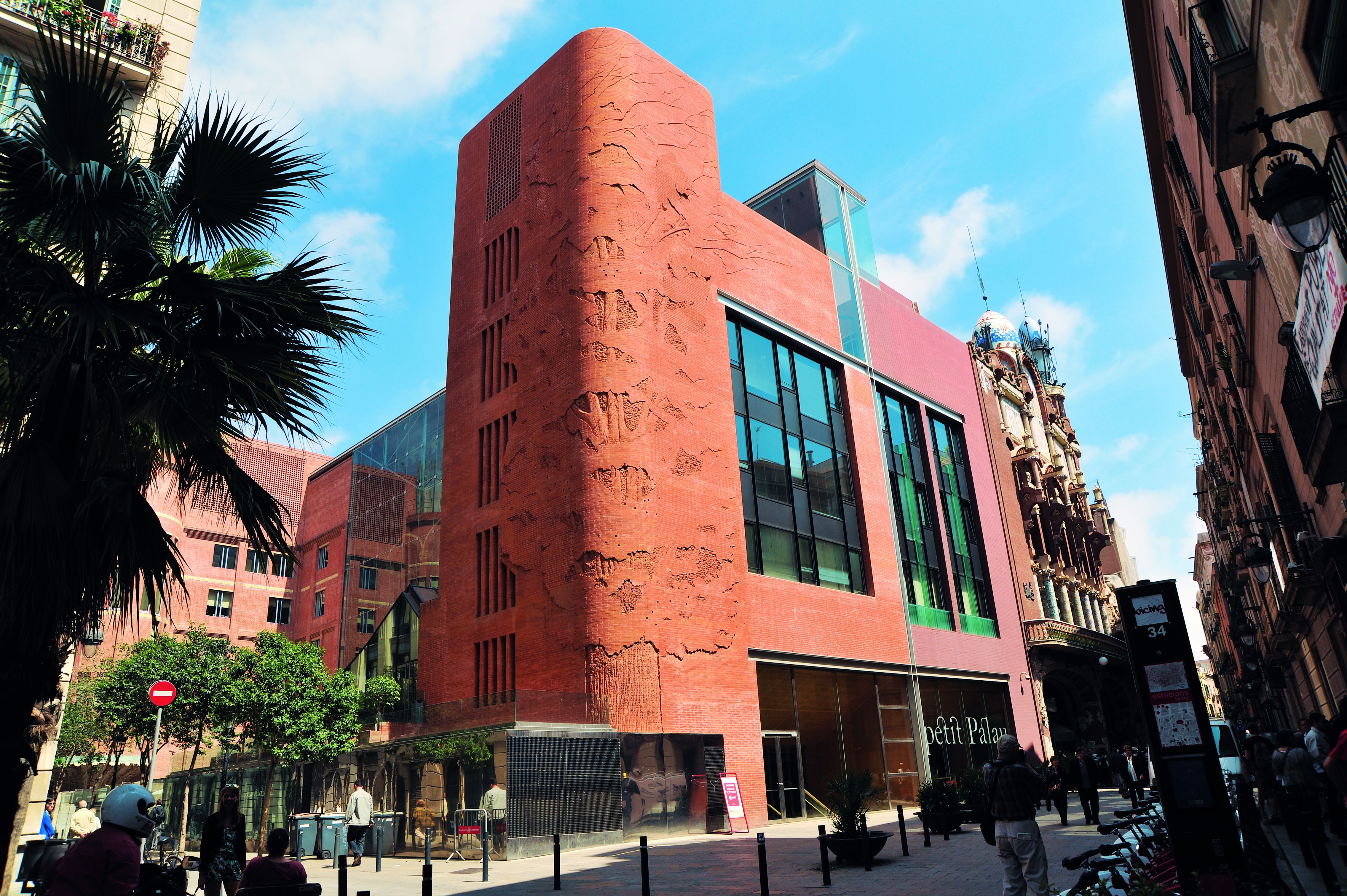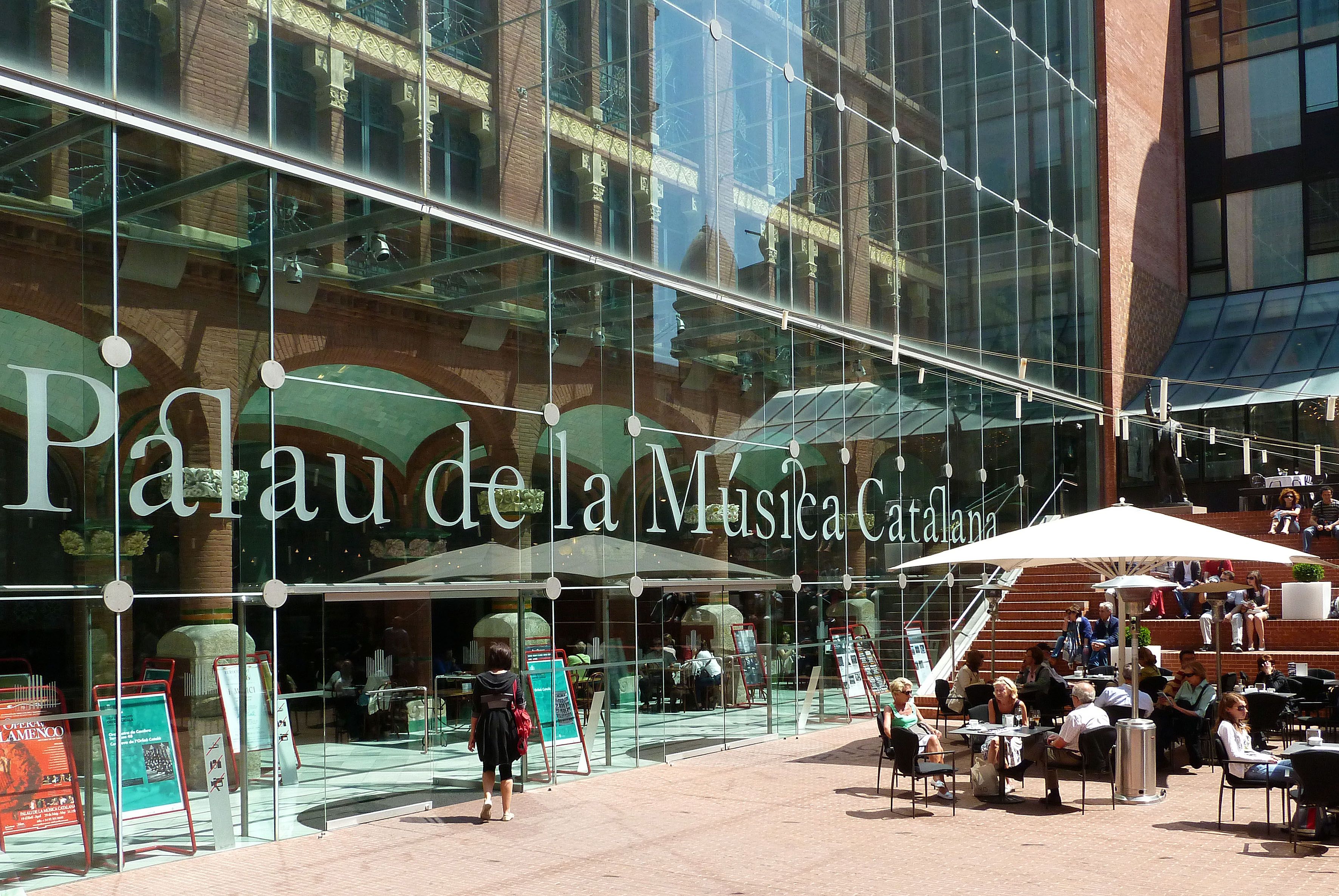The Palau de la Música bewitches visitors with its surreal nature of luxurious colours and flower-crowned dancing nymphs that escape impossibly from the stained glass windows. It is pure exuberance watched over by the severe faces of music’s great masters.Half hidden between the streets of Ramon Mas and Sant Francesc de Paula, the Palau de la Música emerges, as if by magic, as a garden of ceramics, glass and metal.
An explosion of creativity
A second of silence is eternal. That which is produced by the public after hearing a perfect symphony or an aria in the pure voice of a soprano. A silence that is broken by thunderous applause. This is what you feel the first time you enter the Palau de la Música. Exuberant, voluptuous, impressive. We will never run out of adjectives to describe architect Lluís Domènech i Montaner’s magnificent building, the only concert hall to be declared World Heritage by UNESCO in 1997, a Modernista building on all four sides that reflects the will of Barcelona to modernise.
Its history began in 1905, when Lluís Domènech i Montaner, one of the founders of Modernisme, was encharged with building a new concert hall for the Orfeó Català. With total creative freedom, he designed an allegory of nature in nymphs, flowers and plant motifs that made the perfect backdrop for listening to the music. The building was built around a glass-covered metallic structure, a very avant-garde idea for the times, and into it he integrated all the applied arts: sculpture, ironwork, stained glass and ceramics. Domènech i Montaner also wanted light to be an architectural element, so large panels of stained glass, other windows and a central skylight let the sun flood into the Palau. The Modernisme that is reflected by the Palau de la Música is more than an aesthetic trend: it represents an ideological movement that wanted to modernise the city.
A privileged stage
From its inauguration in 1908, the Palau de la Música, nestling right in the centre of the Ciutat Vella district, has been a privileged setting for music, but also for politics and ideas. Great musical masters like Enric Granados, Manuel de Falla, Maurice Ravel, Igor Stravinsky and Frederic Mompou made their debuts in this auditorium. The Palau de la Música is a benchmark not only in the worlds of music and Modernista architecture: is the symbol of an era in Barcelona, the age when it became a modern city.




Cultural heritage
-
Ciutat Vella
Sant Pere, Santa Caterina i la Ribera
-
- Phone number
- Tel.: 932957200
- Fax: 932957210
-
- Web
- https://www.palaumusica.cat
-
- E-mail
- taquilles@palaumusica.cat
-
- Accessibility
- Accessible for people with physical disabilities
-
- Titularity
- Private center
- Address:
- Carrer del Palau de la Música, 2
- Districte:
- Ciutat Vella
- Neighborhood:
- Sant Pere, Santa Caterina i la Ribera
- City:
- Barcelona
- Sections of this equipment
- Sala d'actes
- La botiga del palau
- Petit palau
- Restaurant pizzicato - oyster bar
- Sala de música de cambra
El Palau de la Música Catalana va ser construït entre el 1905 i el 1908 per l'arquitecte Lluís Domènech i Montaner com a seu de l'Orfeó Català, finançat amb fons procedents de subscripció popular.
El Palau de la Música Catalana és una perla arquitectònica del modernisme català, l'única sala de concerts modernista declarada Patrimoni Mundial per la UNESCO (4 de desembre de 1997), que constitueix actualment un punt de trobada ineludible de la vida cultural i social de Catalunya. A més s'ha erigit en patrimoni simbòlic i sentimental de tot un poble que s'identifica amb la seva història.
L'edifici s'articula al voltant d'una estructura central metàl·lica recoberta de vidre, que en rebre la llum natural converteix l'edifici més significatiu de l'obra de Domènech i Montaner en una caixa de música màgica on es combinen totes les arts aplicades: escultura, mosaic, vitrall i forja.
Esdeveniments
-
Concert ''‘Una passió de cinema’'' amb l´Orquestra Simfònica del Vallès & Rubio
28/03/2026
-
Concert per a nadons "Deliciós fiscorn", amb Pep Moliner i la Cia. Musicalmente
24/05/2026
-
Concierto "Pop-rock simfònic" amb l'Orquestra Simfònica del Vallès & Rubio
From 21/02/2026 to 12/04/2026
-
Concert "Händel" amb Balthasar Neumann Orchester, Cor Jove & Hengelbrock
13/03/2026
-
Concert "Schumann i Brahms" amb Christian Zacharias & Leipziger Streichquartett
23/03/2026
-
Concert "Schubert i Beethoven" amb West-Eastern Divan Orchestra & Mehta
18/02/2026
-
Concert ''Grigory Sokolov"
19/02/2026
-
Concert "Bach, Haydn, Schubert, Busoni i Ortiz" amb Noelia Rodiles
30/03/2026
-
Concert "Beethoven, Brahms, Lamote de Grignon i Garreta" amb Ramon Bassal & Maria Canyigueral
18/05/2026
-
Concert "‘La Passione’ de Haydn", amb Gardiner & The Constellation Orchestra
28/05/2026
-
Concert "‘Variacions Enigma’ d’Elgar" amb García García, Martín & Orquestra Simfònica BBC de Gal·les
26/04/2026
-
Concert "Vine tu i les cançons" Homenatge a Conxita Badia
08/05/2026
-
Concert "Let my love be heard" amb Voces8
12/01/2026
-
Concert "Els set somnis de Gaudí’" amb Cor de Cambra, Cor Jove, Cor de Noies, Philharmonia Orchestra & Alsop
10/06/2026
-
Concert "‘Cinquena’ de Beethoven" amb l'Orquestra Simfònica del Vallès, Trio Fortuny & Salado
07/02/2026
-
Concert "‘El trencanous’ de Txaikovski"amb l´Orquestra Simfònica del Vallès & Gil de Tejada
From 25/12/2025 to 10/01/2026
-
Concert ''Cobla 2.0'', amb la Cobla Sant Jordi - Ciutat de Barcelona (a partir de 4 anys)
18/01/2026
-
Concert ''Schubert, Chopin, Brahms, Falla, Szymanowski, Bartók, Ginastera, Piazzolla, Martinů i Albéniz" amb Jan Lisiecki
05/03/2026
-
Concert "Estrena de Gabriela Ortiz" amb Cor de Cambra del Palau, Júlia Sesé & Xavier Puig
21/03/2026
-
Concert ''Homenatge a Montserrat Torrent" Centenari del seu naixement
18/04/2026
-
Tots els ritus: La música "L’amor: De Daphnis et Chloé a Orfeo i Eurídice"
16/01/2026
-
27è Banco Mediolanum Festival Mil·lenni
From 22/10/2025 to 13/03/2026
-
Concert "Les quatre estacions de Vivaldi" amb Janine Jansen & Camerata Salzburg
29/04/2026
-
Concert "Schubert, Schumann i Chopin" amb Igor Levit
12/05/2026
-
Òpera "‘La traviata’ de Verdi" amb l´Orquestra Simfònica del Vallès & Salado
16/05/2026
-
Concert "Escena final de La Valquiria de Wagner" amb Budapest Festival Orchestra & Fischer
27/05/2026
-
Concert "Gaudí", d’Albert Guinovart amb OSTO, Cor Jove & Clemente i Torrebella
25/02/2026
-
Concert "Concerts per a clave de J. S. Bach" amb Il Pomo d'Oro & Corti
17/03/2026
-
Concert "Les Sonates de Brahms" amb Elisabeth Leonskaja
31/03/2026
-
Concert "Carlos Núñez"
From 29/12/2025 to 30/12/2025
-
39è Festival Folk Internacional Tradicionàrius
From 16/01/2026 to 27/03/2026
-
Concert "Ortiz, Matalon, Luna i Maiguashca" amb Frames Percussion
27/01/2026
-
Concert "Andrea Motis + Yamandu Costa"
21/10/2026
-
Concert "Sau presenta Un concert de pel·lícula"
28/12/2025
-
Concert "Haydn i Mozart" amb Camerata Salzburg & Pires
16/01/2026
-
Concert "Buhos"
14/11/2026
-
Concert "Maria del Mar Bonet"
23/05/2026
-
Concert "Ana Torroja"
16/07/2026
-
Concert "Andrea Motis & Barcelona Gospel Messengers"
28/06/2026
-
Òpera "Carmen", de Georges Bizet
From 21/06/2025 to 27/02/2026
-
Concert "‘‘Variacions’ de Rakhmàninov i ‘Caprici italià’ de Txaikovski" amb l'Orquestra Simfònica del Vallès & Larsen-Maguire
09/05/2026
-
Concert ''Furioso: fury, madness and virtuosity of a baroque hero" amb Xavier Sabata & Le Concert de l'Hostel Dieu
11/05/2026
-
Concert "Requiem de Verdi" amb Staatskapelle Dresden, Orfeó Català & Gatti
19/05/2026
-
Concert "Homenatge a Williams i Zimmer" amb l'Orquestra Simfònica del Vallès & Salado
24/05/2026
-
Concert "Mozart, Albéniz, Granados, Liszt i Beethoven" amb Lang Lang
29/05/2026
-
Concert ''Diada Pau Casals 2026" amb "Quartet Casals & Melnikov"
09/06/2026
-
Concert - Gran Final
25/03/2026
-
Barcelona Fashion Summit 2026
29/01/2026
-
Concert "Concert per a piano núm. 2 de Chopin" amb Seong-Jin Cho, London Symphony Orchestra & Noseda
17/02/2026
-
Concert "Concert per a piano de Ligeti", amb Yuja Wang & Mahler Chamber Orchestra
14/01/2026
-
Parlem de... "Orchestre des Champs Élysées & Herreweghe", a càrrec de Sofía Martínez, musicòloga, especialista en entrenament auditiu
05/02/2026
-
Concert "Schubert, Ravel i Ollé" amb Trio Fortuny
04/06/2026
-
Concert "‘Requiem’" amb Frames Percussion, Claraguilar & Cor de Cambra del Palau
30/06/2026
-
Concert ''Debussy, Txaikovski i Prokófiev" amb Beatrice Rana
08/02/2026
-
'Ruta del Modernisme a Barcelona' organitzada per l'Institut Municipal del Paisatge Urbà i la Qualitat de Vida
Permanent event
-
Òpera "La traviata", de G. Verdi
From 17/08/2025 to 22/01/2026
-
Concert "Alex Ubago"
17/09/2026
-
Concert "Marta Santos"
04/02/2026
-
Concert "One Piece Music Symphony"
From 09/02/2026 to 10/02/2026
-
Concert ''Cançons i àries d'òpera" amb Sondra Radvanovsky & Anthony Manoli
21/04/2026
-
Concert "'Quarta’ de Mahler"', amb Prohaska, Liu, Gimeno & Toronto Symphony Orchestra
30/01/2026
-
Concert "Palestrina, Donati i Bruckner" amb Balthasar Neumann Chor & Orchestra & Sow
11/03/2026
-
"Mas i Mas Festival 2026"
From 01/04/2026 to 29/08/2026
-
Concert "Casals, Saariaho, Dall’Abaco i Magrané" amb Guillem Gràcia
26/02/2026
-
Concert "Debussy, Xostakóvitx i Schubert" amb Quartet Vivancos
04/02/2026
-
Concert "Lamote de Grignon, Benejam, Ligeti, Migó, Guinovart i Hindemith" amb SenArts Quintet
01/02/2026
-
Concert "Ommadawn i Tubular Bells de Mike Oldfield" amb Opus One & Xavier Alern
13/02/2026
-
Concert "Ravel, Stravinsky, Ciesla, Reich i Shaw" amb Kebyart & friends
28/04/2026
-
Concert "‘Els planetes’ de Holst" amb l'Orquestra Simfònica del Vallès, Cor de Noies & Puig
30/05/2026
-
Concert "Cor Infantil de l’Orfeó Català & Cor Piccoli Cantori de Torí —Els set elements"
09/07/2026
-
Concert "Colors i més colors —Els mons de Lluís Domènech i Montaner"
03/05/2026
-
Concert "Giorgi Gigashvili —Joves talents internacionals"
27/07/2026
-
Concert "Homenatge a Morricone i Rota" amb l'Orquestra Simfònica del Vallès & Pasquina
From 16/12/2025 to 09/01/2026
-
Concert "Mozart, Mahler, Schreker, Zemlinsky i Wolf" amb Elionor Martínez & Victoria Guerrero
13/05/2026
-
Concert ''Julia Kleiter & Julius Drake —Lieder alemanys"
01/06/2026
-
Concert "Judith Jáuregui & Franz Schubert Filharmonia" ‘Noches en los jardines de España’
03/06/2026
-
Concert "Cor Petits, Cor Mitjans & Coral Xiquets de l’Orfeó Lleidatà" —"Les estacions!"
06/06/2026
-
Concert ''‘Banda Municipal de Barcelona & Pascual-Vilaplana —Brotons i Guinovart"
11/06/2026
-
Concert "Scarlatti, Bononcini, Marcello, Corelli i Händel" amb Ensemble 1700, De Sa & Oberlinger
26/01/2026
-
42a Temporada Ibercamera
From 05/11/2025 to 09/04/2026
-
Concert "Schubert, Wolf, Marx, Korngold, A. Mahler i Berg" amb Beatriz Miranda & Teodora Oprisor
From 20/04/2026 to 20/06/2026
-
Concert "Guix, Le Beau, Cànovas i Hindemith" amb Anna Puig
16/04/2026
-
Concert''Jazz en viu... Swing!'' Iniciació a la música de jazz per descobrir el swing (a partir de 8 anys)
25/01/2026
-
Concert "Meravellós Mahler!'' (a partir de 8 anys)
From 06/12/2025 to 08/03/2026
-
Concert ''Les quatre estacions'' de Vivaldi, amb Vespres d’Arnadí, James & Espasa
From 20/12/2025 to 11/01/2026
-
Concert ''El Messies'' de Händel, amb Vespres d'Arnadí, Cor de Cambra de Granollers & Puig
From 14/12/2025 to 11/01/2026
-
Òpera "La traviata" de Giuseppe Verdi
From 03/05/2025 to 02/05/2026
-
Concert ''‘Mites i sons de la terra’" amb l´Orquestra Simfònica Camerata XXI, Blanch & Montané
26/05/2026
-
Òpera "‘Turandot’" amb Tomàs Grau & Franz Schubert Filharmonia
From 25/04/2026 to 27/04/2026
-
Concert "Wagner i Schumann" amb Nikolai Lugansky
07/05/2026
-
Concert "Jaeden Izik-Dzurko —Schubert, Schumann i Medtner"
15/06/2026
-
Òpera "‘Norma’ de Bellini" amb l´Orquestra Simfònica del Vallès & García Vico
07/03/2026
-
Visita lliure amb audioguia al Palau de la Música Catalana
Permanent event
-
Concert ''Lieder i àries d'òpera" amb Piotr Beczała & Sarah Tysman
13/04/2026
-
Concert "Explosió i revolució musical", a càrrec de la Orquestra de Cambra Big Bang Beethoven
From 19/10/2025 to 07/02/2026
-
Concert "Schubert, Brahms, Toldrà i Guastavino", amb 5 elements: Mathéu, Pintó, Padullés, Martín-Royo & Angelov
25/03/2026
-
Concert "Violin Concerto’ & ‘West Side story’', amb Leticia Moreno & Franz Schubert Filharmonia
18/01/2026
-
Concert ''‘Granada 1920’" amb Daniel Ligorio & Borja Espinosa
15/04/2026
-
Concert per a nadons i petits ''Twinkle, twinkle, Baby's star'' (0 a 5 anys)
From 13/12/2025 to 31/05/2026
-
Espectacle "Recital de violí" amb Joshua Bell
11/02/2026
-
Concert "Simfonies núm. 2 i 8 de Beethoven" amb Orchestre des Champs Élysées & Herreweghe
05/02/2026
-
Concert ''Falla i Chopin" amb Javier Perianes
12/02/2026
-
Concert "‘Cançó d’amor i de guerra’ i ‘Marina’" amb l'Orquestra Simfònica del Vallès, Cor Madrigal & Puig
14/02/2026
-
Concert "Schéhérazade!" amb l'Orquestra Simfònica del Vallès, Thomas & Salado
24/01/2026
-
Concert "Diada de l’Antic Cantaire" amb Xarxa Coral
22/03/2026
-
Cicle de concerts "BCN Clàssics". Temporada 2025-2026
From 03/11/2025 to 28/05/2026
-
Concert "El amor brujo de Falla" amb l´Orquestra Simfònica Julià Carbonell de les Terres de Lleida & Pagès-Corella
17/03/2026
-
Concert "Beethoven i García-Tomás" amb Camerata Penedès & Borrani
20/02/2026
-
Itinerari guiat + taller artístic 'Visitem i experimentem el Palau' (per a infants de 5 a 10 anys)
From 09/11/2025 to 19/04/2026
-
Concert ''Flamenkat'' Sonoritats d’aquí, d’allí i d’ara' (a partir de 6 anys)
From 30/11/2025 to 19/04/2026
-
Concert ''Schubert, Franck, Debussy i Ortiz" amb María Dueñas & Alexander Malofeev
17/04/2026
-
'Concert of Sant Esteve', in charge of Cors de l'Orfeó Català and Cor de Cambra del Palau
26/12/2025
-
Concert de Palau Vincles "Estrena de la cantata de Marc Timón''
03/03/2026
-
Visita guiada al Palau de la Música Catalana
From 30/01/2026 to 31/01/2026
-
Concert "Bach, Beethoven i Schubert" amb Víkingur Ólafsson
12/03/2026
-
Concert "El ‘Concert per a piano’ de Chopin" amb Yulianna Avdeeva & Franz Schubert Filharmonia
08/02/2026
-
Concert "El Kanka"
18/03/2026
-
Espectacle "Gran Gala Flamenc"
From 30/05/2025 to 01/01/2026
-
Concert "Homenatge a Williams i Zimmer", amb l'Orquestra Simfònica del Vallès & Salado
06/01/2026
-
Concert "'Missa en Si menor’ de J. S. Bach" amb Vespres d'Arnadí, Cor de Cambra del Palau & Puig
31/01/2026
-
Concert "‘Requiem’ de Mozart" amb Orquestra Simfònica del Vallès, Cor Madrigal & Espasa
From 26/10/2025 to 29/03/2026
-
Cruïlla Hivern 2026
From 18/01/2026 to 25/03/2026
-
Concert "Barcelona Guitar Trio & Dance. Homenatge a Paco de Lucía"
From 27/05/2025 to 30/12/2025
-
Concert de música clàssica per a nadons i petits ''BaBeBra & Mozart'' (de 0 fins a 5 anys)
From 01/11/2025 to 06/04/2026
-
Concert "Mússorgski i Khatxaturian" amb Conunova, Raiskin & Orquestra Filharmònica Eslovaca
02/03/2026
-
Concert "Boulanger, Cànovas, Lladó i Viloria" amb Lluïsa Espigolé
22/12/2025
-
Concert "Berg, Korngold, Zemlinsky, Schönberg i Mahler" amb Gerrit Illenberger & Rebeka Stojkoska
03/03/2026
-
Concert "Schumann i Brahms" amb Trio Fortuny & friends
27/02/2026
-
Òpera "Giulio Cesare de Händel", amb Il Pomo d’Oro & Francesco Corti
15/02/2026
-
Concert "Gipsy Kings (by André Reyes)"
27/12/2025
-
Concert ''András Schiff"
24/02/2026
-
Concert "L'ocell de foc de Stravinsky" amb Soltani, Orquestra Simfònica d'Islàndia & Ollikainen
18/03/2026
-
Concert "Daphnis et Chloé de Ravel" amb l´Orquestra Simfònica de la SWR d’Stuttgart & Roth
20/01/2026
-
Concert "Ortiz, Shaw, Kahane i Smith" amb Attacca Quartet
23/01/2026
-
Concert "La Creació de Haydn" amb Vespres d’Arnadí, Coral Cantiga & Colomer
19/04/2026
-
Concert "Mendelssohn, Schumann, Boulanger i Clarke" amb Sheku & Isata Kanneh-Mason
23/02/2026
-
Concert "In illo tempore" amb Mayte Martín
07/04/2026
-
Concert ''Julia Lezhneva & Il Giardino Armonico"
10/03/2026
-
Visites guiades al Palau de la Música Catalana
Permanent event
-
Concert ''‘La Gran’ de Schubert" amb Leonard Slatkin & Franz Schubert Filharmonia
22/03/2026
-
Espectacle "Festa de la Música Coral"
01/03/2026
-
Concert ''Beethoven, Schubert, Schumann, Brahms, Schönberg, Stockhausen i Sherman" amb Stephen Hough
19/01/2026
-
Concert "‘Concerts de Brandenburg’" amb Concentus Musicus Wien & Gottfried
16/03/2026
-
Concert "‘Passió segons sant Joan’" amb Monteverdi Choir, EBS & Peter Whelan
06/03/2026
-
Concert "Les quatre estacions: Hivern"
22/12/2025
-
Parlem de... "Yuja Wang & Mahler Chamber Orchestra", a càrrec d’Ana María Dávila, periodista musical
14/01/2026
-
Parlem de... "Orquestra Simfònica de la SWR d’Stuttgart & Roth", a càrrec de Jaume Radigales, professor de la Universitat Ramon Llull i crític musical
20/01/2026
-
Concert "Cobla Sant Jordi-Ciutat de Barcelona" amb Miquel Massana
27/04/2026
-
Concert "La ‘Cinquena’ de Txaikovski" amb Midori & Franz Schubert Filharmonia
17/05/2026
-
Concert "Sabrina Gárdez & Bernardo Rambeau" —"L’esperit cosmopolita de la música espanyola"
12/06/2026
-
Concert d'Any Nou amb l´Orquestra Simfònica del Vallès & Rubio
From 28/12/2025 to 04/01/2026
-
Concert "Lucas i Arthur Jussen, Gerassimez & Kuyumcuyan —Bartók, Gerassimez, Gershwin, Bernstein i Adams"
17/06/2026
-
Concert "Boulanger, Garreta, Guinjoan i Sibelius" amb OBC & Childress
22/05/2026
-
Exposició "Rituals for the unknown", de Carsten Gueth
From 23/10/2025 to 15/01/2026
-
Concert "‘Passió segons Sant Mateu’" amb Arcangelo & Cohen
27/03/2026
-
Concert "Cobla Sant Jordi-Ciutat de Barcelona & Miquel Massana"
16/06/2026
-
Concert "‘Ortiz, Márquez i Ginastera" amb l'Orquestra Simfònica del Vallès & Salado
11/04/2026
-
Concert "Pat Metheny Side-Eye III+"
23/07/2026
-
Concert "Barcelona Jazz Orquestra. Tot recordant Satchmo (homenatge a Louis Armstrong)"
22/10/2026
-
Concert "Duncan Dhu - Mikel Erentxun"
15/01/2026
-
Concert "Sofiane Pamart"
20/03/2026
-
Concert "Ramon Mirabet All Stars Jazz Project"
28/11/2026
-
Concert "Maika Makovski"
04/03/2026
-
Concert "Zimmer, Williams i 100 anys de cinema"
07/01/2026
-
Concert inaugural "Llach - Gener 76 50 anys dels Concerts de la Transició"
From 27/01/2026 to 28/01/2026
-
Concert "Els amics de les Arts"
16/04/2026
-
Concert "We want Miles!"
24/07/2026
-
Visita guiada 'El Palau en Veu Femenina'
From 22/11/2025 to 17/01/2026
-
Concert de l'Orquestra de Músiques d’Arrel de Catalunya "CRUI"
13/01/2026
If you would like to make a correction related to this activity...
LET US KNOW




